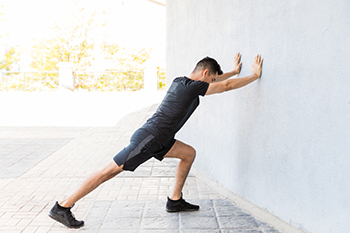
Stress fractures are tiny cracks in bones that develop from repetitive force or overuse, making them a common issue among runners and athletes. They often occur in the weight-bearing bones of the foot where repeated impact can exceed the bone’s ability to repair itself. Symptoms include localized pain that worsens with activity, swelling, tenderness, and difficulty walking. Risk factors include sudden increases in training intensity, wearing improper footwear, poor running mechanics, or low bone density. A podiatrist can evaluate the injury through a physical examination and imaging tests, suggest supportive footwear or custom orthotics, and recommend activity modifications. If you enjoy running and have developed consistent foot pain, it is suggested that you promptly consult a podiatrist who can offer relief, treatment, and prevention tips for foot and ankle injuries.
Stress fractures occur when there is a tiny crack within a bone. To learn more, contact Lauryn Smith-Winton, DPM from S.W. Podiatry Group. Our doctor can provide the care you need to keep you pain free and on your feet.
How Are They Caused?
Stress fractures are the result of repetitive force being placed on the bone. Since the lower leg and feet often carry most of the body’s weight, stress fractures are likely to occur in these areas. If you rush into a new exercise, you are more likely to develop a stress fracture since you are starting too much, too soon. Pain resulting from stress fractures may go unnoticed at first, however it may start to worsen over time.
Risk Factors
- Gender – They are more commonly found in women compared to men.
- Foot Problems – People with unusual arches in their feet are more likely to develop stress fractures.
- Certain Sports – Dancers, gymnasts, tennis players, runners, and basketball players are more likely to develop stress fractures.
- Lack of Nutrients – A lack of vitamin D and calcium may weaken the bones and make you more prone to stress fractures
- Weak Bones – Osteoporosis can weaken the bones therefore resulting in stress fractures
Stress fractures do not always heal properly, so it is important that you seek help from a podiatrist if you suspect you may have one. Ignoring your stress fracture may cause it to worsen, and you may develop chronic pain as well as additional fractures.
If you have any questions please contact our office located in Waldorf, MD . We offer the newest diagnostic and treatment technologies for all your foot and ankle needs.

Peroneal tendinitis involves irritation of the two peroneal tendons that run behind the outer ankle and attach to the side of the foot. This irritation, which develops from repeated strain, is common among runners and endurance athletes. When the peroneal tendons become irritated, the outer foot and ankle can feel sore and stiff. Gentle stretching helps maintain motion while reducing tightness in the surrounding tissues. A towel stretch, a standing calf stretch, and controlled inward and outward foot movements keep the ankle flexible and support healthier tendon function. These stretches also help reduce pressure on the tendons and improve comfort as the foot heals. With proper rest and conservative management, this condition often improves without surgery, but guidance is helpful. A podiatrist can explain which stretches are safe and recommend further care. If you are experiencing symptoms of peroneal tendinitis, it is suggested that you make an appointment with a podiatrist for a diagnosis and treatment.
Stretching the feet is a great way to prevent injuries. If you have any concerns with your feet consult with Lauryn Smith-Winton, DPM from S.W. Podiatry Group. Our doctor will assess your condition and provide you with quality foot and ankle treatment.
Stretching the Feet
Being the backbone of the body, the feet carry your entire weight and can easily become overexerted, causing cramps and pain. As with any body part, stretching your feet can serve many benefits. From increasing flexibility to even providing some pain relief, be sure to give your feet a stretch from time to time. This is especially important for athletes or anyone performing aerobic exercises, but anyone experiencing foot pain or is on their feet constantly should also engage in this practice.
Great ways to stretch your feet:
- Crossing one leg over the others and carefully pull your toes back. Do 10-20 repetitions and repeat the process for each foot
- Face a wall with your arms out and hands flat against the wall. Step back with one foot and keep it flat on the floor while moving the other leg forward. Lean towards the wall until you feel a stretch. Hold for 30 seconds and perform 10 repetitions for each foot
- Be sure not to overextend or push your limbs too hard or you could risk pulling or straining your muscle
Individuals who tend to their feet by regular stretching every day should be able to minimize foot pain and prevent new problems from arising.
If you have any questions please contact our office located in Waldorf, MD . We offer the newest diagnostic and treatment technologies for all your foot and ankle needs.

Ankle sprains in children are common injuries that occur when the ligaments supporting the ankle stretch or tear, often due to running, jumping, or sudden twists during sports and play. The ankle may look swollen, bruised, or slightly deformed, and the child may have difficulty putting weight on the affected foot. Many children describe sharp pain at the time of injury, followed by tenderness, stiffness, or a feeling of instability. Repeated ankle sprains in childhood can increase the risk of chronic ankle instability later in life if not properly treated. A podiatrist can begin by examining the ankle, assessing the range of motion, and using imaging if necessary to rule out fractures or growth plate injuries. Treatment may include elevation, supportive braces, targeted exercises, and guidance on safe return to activity. Early care supports proper healing, prevents recurring injuries, and maintains mobility. If your child experiences persistent pain, swelling, or difficulty walking after an ankle injury, it is suggested that you make an appointment with a podiatrist.
Although ankle sprains are common, they aren’t always minor injuries. If you need your ankle injury looked at, contact Lauryn Smith-Winton, DPM from S.W. Podiatry Group. Our doctor can provide the care you need to keep you pain-free and on your feet.
How Does an Ankle Sprain Occur?
Ankle sprains are the result of a tear in the ligaments within the ankle. These injuries may happen when you make a rapid shifting movement while your foot is planted. A less common way to sprain your ankle is when your ankle rolls inward while your foot turns outward.
What Are the Symptoms?
- Pain at the sight of the tear
- Bruising/Swelling
- Ankle area is tender to touch
- In severe cases, may hear/feel something tear
- Skin discoloration
Preventing a Sprain
- Wearing appropriate shoes for the occasion
- Stretching before exercises and sports
- Knowing your limits
Treatment of a Sprain
In many cases, the RICE method (Rest, Ice, Compression, and Elevate) is used to treat ankle sprains. However, you should see a podiatrist to see which treatment option would work best with your injury. In severe cases, surgery may be required.
It is important to ask your doctor about rehab options after you receive treatment for your injury. Stretching, strength training, and balance exercises may help the ankle heal while also preventing further injury.
If you have any questions, please feel free to contact our office located in Waldorf, MD . We offer the newest diagnostic and treatment technologies for all your foot care needs.

